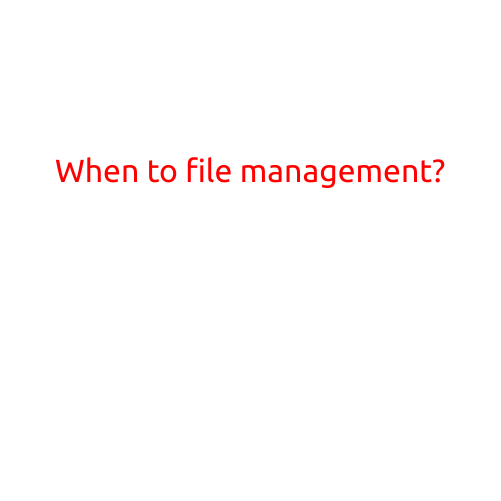
When to File Management?
In today’s digital age, it’s easy to get overwhelmed by the sheer amount of data and information we encounter on a daily basis. This can be especially true for professionals who are required to manage large volumes of documents and records on a regular basis. Effective file management is crucial for maintaining organization, reducing stress, and increasing productivity. But when is the right time to implement file management?
Why File Management is Important
File management is essential for keeping your digital life in order. It helps you to:
- Organize and categorize your files and documents in a logical and logical manner
- Quickly locate and retrieve the information you need, when you need it
- Reduce clutter and minimize the risk of lost or misplaced files
- Improve collaboration and communication with colleagues and clients
- Comply with regulations and standards that require the proper management of sensitive data
When to File Management?
So, when is the right time to implement file management? Here are some signs that it’s time to give your digital organization a makeover:
- You’re feeling overwhelmed: If you’re constantly struggling to find specific files or documents, it’s likely that your file management system is in disarray.
- You’re experiencing data redundancy: If you find yourself duplicating efforts or re-creating the same files multiple times, it’s a sign that your file management system needs to be streamlined.
- You’re facing compliance issues: If you’re responsible for managing sensitive data, such as customer information or financial records, and you’re not sure where it’s stored or if it’s secure, it’s time to implement a robust file management system.
- You’re starting a new project or initiative: Anytime you’re starting a new project or initiative, it’s a good idea to implement a file management system to keep track of files, documents, and communications.
- You’re moving to a new role or department: When you’re transitioning to a new role or department, it’s an opportunity to re-evaluate and re-organize your file management system for greater efficiency and productivity.
Best Practices for Implementing File Management
If you’re ready to implement file management, here are some best practices to keep in mind:
- Start small: Begin by organizing a small set of files or documents and gradually build up to larger collections.
- Use clear and descriptive names: Avoid using generic or ambiguous file names and instead opt for descriptive and specific names that reflect the contents of the file.
- Create folders and subfolders: Organize your files into logical folders and subfolders to make them easy to locate and access.
- Use tags and metadata: Use tags and metadata to add additional context and meaning to your files, making them easier to search and retrieve.
- Back up your files: Regularly back up your files to an external hard drive, cloud storage, or other secure location to ensure that your data is safe and recoverable in the event of a disaster.
Conclusion
Effective file management is essential for staying organized, reducing stress, and increasing productivity. By recognizing the signs that it’s time to implement file management and following best practices for organizing and categorizing your files, you can create a system that serves you well for years to come. Whether you’re a busy professional, a small business owner, or a home user, file management is an essential tool for maintaining control and order in your digital life.





